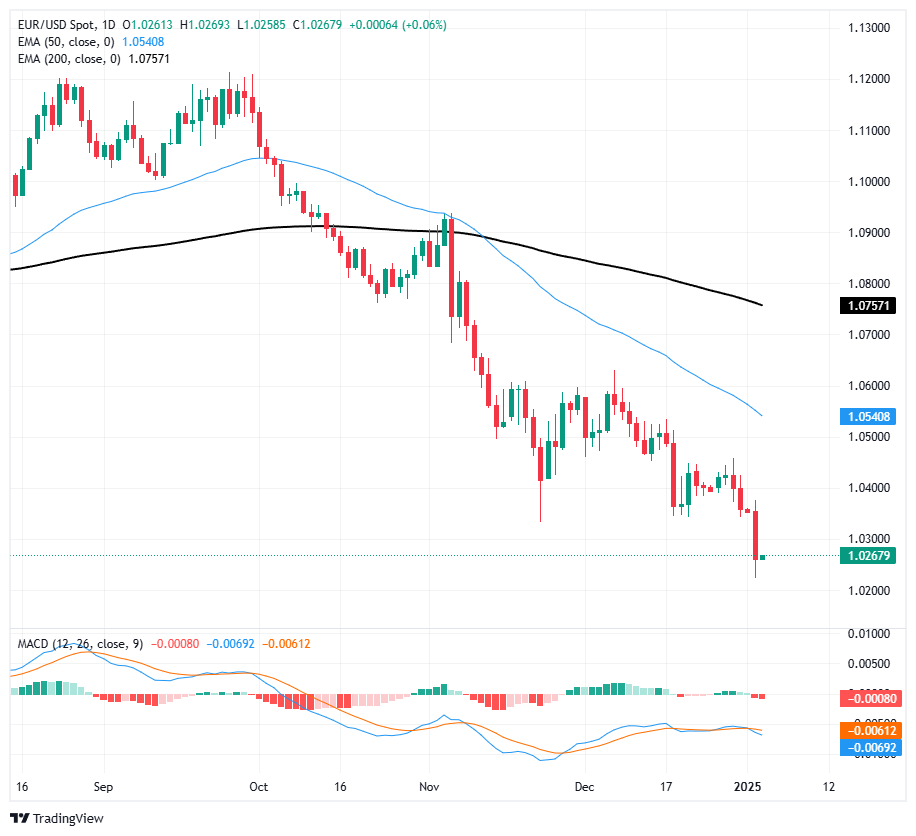EUR/USD kicks off 2025 with a fresh move to the downside
- EUR/USD fell 0.8% on the first trading day of the new year.
- Bearish sentiment looms large over the battered Euro.
- Rate differential set to widen further, analysts expect parity in 2025.
EUR/USD took another leg lower to kick off the 2025 trading season, falling eight-tenths of one percent and tapping the 1.0250 level for the first time since November of 2022, a nearly 26-month low. European Manufacturing Purchasing Managers Index (PMI) data missed the mark on Thursday, only adding to Euro traders’ woes following a dovish appearance from European Central Bank (ECB) policymaker Yannis Stournaras later in the day.
According to ECB Governing Council member Yannis Stournaras, the ECB is on pace to trim interest rates in a steady decline through 2025. The ECB is expected to land somewhere in the neighborhood of 2% later this year, according to the ECB’s Stournaras. With the Federal Reserve (Fed) on pace to trim interest rates at a much slower pace than previous expected in 2025, the Euro’s interest rate differential is set to widen significantly through the rest of the year, which will keep downward pressure on EUR/USD in the long run. This falls in line with expectations from some analysts who are calling for the Euro to hit parity with the Greenback sometime this year.
Pan-European PMI survey results fell slightly in December, ticking down to 45.1 versus the expected hold at 45.2. While the data itself had a relatively low impact, it helped to highlight the increasing likelihood that the European Central Bank (ECB) would accelerate rate cuts to bolster the European economy, even as petrol prices hit their own two-year highs, further flummoxing the European economic outlook.
The only meaningful data of note on Friday’s economic calendar is US ISM Manufacturing PMI survey results, which are expected to hold steady at a contractionary 48.4 for December.
EUR/USD price forecast
EUR/USD is down 8.82% top-to-bottom from September’s peak bids just above the 1.1200 handle, though short-sellers remain unable to pierce 1.0200 for now. A bearish divergence on the Moving Average Convergence-Divergence (MACD) indicator is getting hard to ignore, implying further technical losses on the horizon.
Fiber bids are getting pushed further down by a descending 50-day Exponential Moving Average (EMA) falling into 1.0550. If bidders are able to stage a comeback beyond this point, the 200-day EMA will be waiting just above at 1.0760.
EUR/USD daily chart
Euro FAQs
The Euro is the currency for the 19 European Union countries that belong to the Eurozone. It is the second most heavily traded currency in the world behind the US Dollar. In 2022, it accounted for 31% of all foreign exchange transactions, with an average daily turnover of over $2.2 trillion a day. EUR/USD is the most heavily traded currency pair in the world, accounting for an estimated 30% off all transactions, followed by EUR/JPY (4%), EUR/GBP (3%) and EUR/AUD (2%).
The European Central Bank (ECB) in Frankfurt, Germany, is the reserve bank for the Eurozone. The ECB sets interest rates and manages monetary policy. The ECB’s primary mandate is to maintain price stability, which means either controlling inflation or stimulating growth. Its primary tool is the raising or lowering of interest rates. Relatively high interest rates – or the expectation of higher rates – will usually benefit the Euro and vice versa. The ECB Governing Council makes monetary policy decisions at meetings held eight times a year. Decisions are made by heads of the Eurozone national banks and six permanent members, including the President of the ECB, Christine Lagarde.
Eurozone inflation data, measured by the Harmonized Index of Consumer Prices (HICP), is an important econometric for the Euro. If inflation rises more than expected, especially if above the ECB’s 2% target, it obliges the ECB to raise interest rates to bring it back under control. Relatively high interest rates compared to its counterparts will usually benefit the Euro, as it makes the region more attractive as a place for global investors to park their money.
Data releases gauge the health of the economy and can impact on the Euro. Indicators such as GDP, Manufacturing and Services PMIs, employment, and consumer sentiment surveys can all influence the direction of the single currency. A strong economy is good for the Euro. Not only does it attract more foreign investment but it may encourage the ECB to put up interest rates, which will directly strengthen the Euro. Otherwise, if economic data is weak, the Euro is likely to fall. Economic data for the four largest economies in the euro area (Germany, France, Italy and Spain) are especially significant, as they account for 75% of the Eurozone’s economy.
Another significant data release for the Euro is the Trade Balance. This indicator measures the difference between what a country earns from its exports and what it spends on imports over a given period. If a country produces highly sought after exports then its currency will gain in value purely from the extra demand created from foreign buyers seeking to purchase these goods. Therefore, a positive net Trade Balance strengthens a currency and vice versa for a negative balance.


